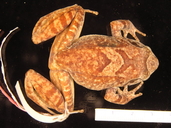|
Arthroleptis nikeae Poynton, 2003
Nike's Squeaker Frog | family: Arthroleptidae genus: Arthroleptis |
| Species Description: Poynton, J.C. 2003. A New Giant Species of Arthroleptis (Amphibia:Anura) from the Rubeho Mountains, Tanzania. African Journal of Herpetology, 52(2)107-112. | |
 © 2010 David Blackburn (1 of 2) |
|
|
|
Description Arthroleptis nikeae is very similar to A. tanneri and A. affinis, two other large Arthroleptis frogs. Telling the three species apart is based on tympanum size and tibia length. Arthroleptis tanneri has a smaller tympanum to body length ratio compared to A. affinis. Arthroleptis affinis has a longer tibia length to body length ratio compared to A. tanneri. Arthroleptis nikeae sits in between these two other species with a small tympanum like A. tanneri and a long tibia like A. affinis (Poynton 2003). The juveniles of A. nikeae and A. affinis are easily confused but can be differentiated by close examination of the tympanum, sizes of discs, and possibly from markings (Poynton 2003). In preservative, the background body color is light brown, but it has several areas of darker pigmentation. The most anterior patch of dark coloration an interrupted line that connects the snout to the eyes. Between the eyes is a bar that extends over the occipital region before splitting and continuing to the scapular region. The tympanum has a dark patch that covers at least ⅔ of its surface. There is an inverted V-shaped bar on dorsum at the sacral region, which matches the scapular bifurcation. There is dark banding on the legs with two main broad bands on each femur and three main bands on the tibias. There is also dark marbling on the flanks. Its ventral side is pale with a few freckles. The cornified skin of the outer metatarsal tubercle is also dark. (Poynton 2003) Most of the variation in A. nikeae comes from its coloration. For example, sometimes the inverted V-shaped markings on its dorsum are not clearly defined; sometimes the eye stripe completely covers the tympanum and other times it only covers roughly ⅔ of it. Other areas of variation include occasional warts behind the jaw and no supernumerary metatarsal tubercles (Poynton 2003). Additionally, based on what is known about most other members of Arthroleptis, there are potential sexual characteristics that distinguish males from females (Zimkus and Blackburn 2008). Distribution and Habitat Country distribution from AmphibiaWeb's database: Tanzania, United Republic of
Life History, Abundance, Activity, and Special Behaviors The exact reproductive behavior of Arthroleptis nikeae is unknown, but we can be fairly certain that it displays direct development because all other known members of the Arthroleptis genus have direct development (Blackburn and Zimkus 2008). Eggs found in gravid females were unpigmented and had an in situ diameter of 2.06 mm. However, it is possible they were not fully developed (Poynton 2003). The current population size of Nike’s squeaker is unknown, but it is believed to be common in the Mafwomero Forest. It probably has a smaller population size than other Arthroleptis frogs because it is constricted to such a small geographic range. Within the Rubeho Mountains, its area of occupancy is essentially the size of the Mafwomero Forest, which is approximately 3.3 km2. This is the only known location where Arthroleptis nikeae occurs (IUCN 2014). Trends and Threats Additionally, it is not known if there are other populations of A. nikeae elsewhere. Loss of the surrounding areas could potentially impact the species if other populations are discovered in neighboring forests. While the Mafwomero Forest and boundaries are largely intact, clearing of forest around the boundaries of other reserves can have an impact on A. nikeae. In Mafwomero particularly, there are high rates of pit sawing, which could be detrimental to the species (Doggart et al. 2006). Possible reasons for amphibian decline General habitat alteration and loss Comments Arthroleptis (squeaker frogs) and Cardioglossa (long-fingered frogs) are sister genera in family Arthroleptidae. The Arthroleptis genus evolved direct development and small body size at the base of its phylogeny, which helped it radiate into a wide range of habitat types across Africa (Zimkus and Blackburn 2008). Arthroleptis nikeae was named after conservationist, Nike Doggart, who collected the specimens. The species was discovered on August 21, 2001 during a Tanzania Forest Conservation Group survey of the Rubeho Mountains of the Eastern Arc Mountain range (Poynton 2003). The Arthroleptis genus that Nike’s squeaker belongs to has the most reduced karyotype known in Anurans (2n = 14) (Zimkus and Blackburn 2008).
References
Doggart, N., Perkin, A., Kiure, J., Fjeldså, J., Poynton, J., Burgess, N. (2006). ''Changing places: how the results of new field work in the Rubeho Mountains influence conservation priorities in the Eastern Arc Mountains of Tanzania.'' African Journal of Ecology, 44(2), 134-144. Forrester-Kibuga, K., Mlowe, D., Doggart, N. (2007) ''Participatory environmental action plans for five villages surrounding Mafwomero Forest Reserve in the Rubeho Mountains.'' Tanzania Forest Conservation Group Technical Paper No 16. DSM Tz pp 1 – 41 IUCN SSC Amphibian Specialist Group. (2014). Arthroleptis nikeae. The IUCN Red List of Threatened Species 2014: e.T54377A16934273. Downloaded April 2017 Poynton, J.C. (2003). ''A new giant species of Arthroleptis (Amphibia: Anura) from the Rubeho Mountains, Tanzania.'' African Journal of Herpetology, 52(2), 107-112. Zimkus, B.M., Blackburn, D.C (2008). ''Distinguishing features of the sub-Saharan frog genera Arthroleptis and Phrynobatrachus: a short guide for field and museum researchers.'' Breviora , 513, 1-12. Originally submitted by: Christina Scott, Erin Gawel, Maddy Schwarz (first posted 2018-03-15) Edited by: Ann T. Chang (2023-03-07) Species Account Citation: AmphibiaWeb 2023 Arthroleptis nikeae: Nike's Squeaker Frog <https://amphibiaweb.org/species/6247> University of California, Berkeley, CA, USA. Accessed Jun 10, 2025.
Feedback or comments about this page.
Citation: AmphibiaWeb. 2025. <https://amphibiaweb.org> University of California, Berkeley, CA, USA. Accessed 10 Jun 2025. AmphibiaWeb's policy on data use. |


 Map of Life
Map of Life